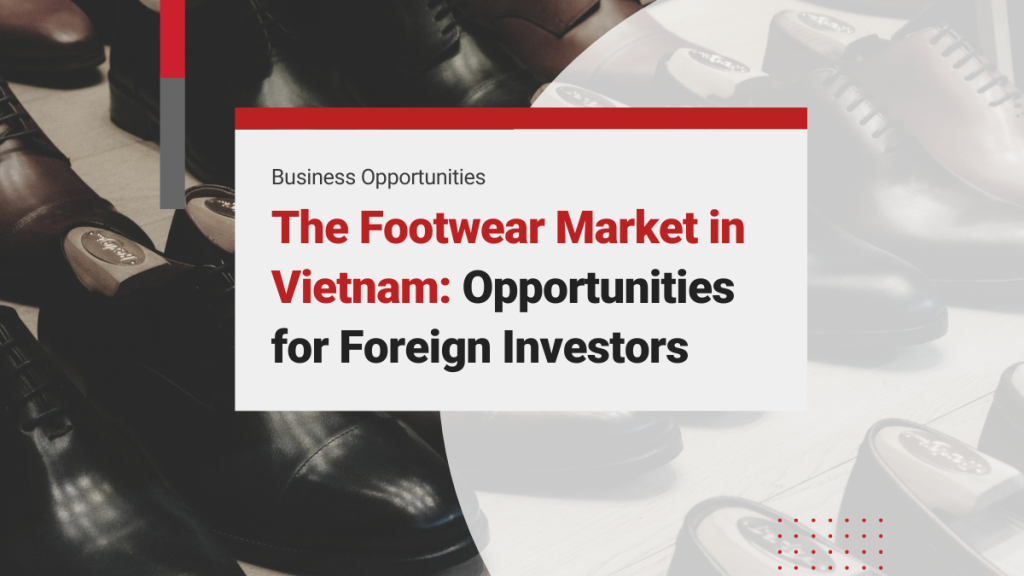Vietnam’s footwear market is experiencing steady growth, driven by an expanding customer base and evolving consumer preferences. The market is characterized by intense competition among both local and international brands, creating a vibrant landscape where innovation and quality are paramount. Urbanization and the growth of the middle class in Vietnam are creating new opportunities for both local and international footwear brands.
Vietnam’s consumer market is projected to become the 11th largest globally by 2030, with a notable increase in the number of consumers. This growth is reflected in the market’s expected compound annual growth rate of 5.90% from 2024 to 2032. The increasing availability of online retail channels is further enhancing consumer shopping experiences, contributing to the market’s expansion.
Vietnam’s footwear manufacturing industry is strengthened by an expanding supply chain, establishing the country as a significant player in the market. The nation ranks as the world’s second-largest footwear exporter and is projected to see continued growth in export revenues. With approximately 2,200 footwear companies concentrated near the city of Ho Chi Minh, the industry is well-positioned to capitalize on the growing demand for high-quality footwear.
Investing in Footwear Market in Vietnam? Check out InCorp Vietnam’s Incorporation Services in Vietnam
Vietnam’s Consumer Market Outlook to 2030
Vietnam’s consumer market is poised to become the 11th largest globally by 2030, with a projected population of 80 million—an increase of 34% from 2024. This growth, coupled with a rising number of individuals earning over US$20 per day, signals a surge in disposable income. These economic trends, combined with Vietnam’s skilled workforce and competitive production costs, are attracting global brands to establish manufacturing operations in the country.
Consumer preferences are also shifting toward sustainable footwear, driven by heightened environmental awareness. Vietnam solidifies its role as a global footwear leader, ranking as the second-largest exporter of leather and footwear, with over 1 billion pairs exported annually. Major players like Nike and Adidas have a strong presence, with Nike operating 96 factories and sourcing from over 100 suppliers, primarily in the southern region. In 2021, Vietnam accounted for 40% of Adidas’s footwear production, reinforcing its importance in global supply chains.
The combination of economic growth and an expanding middle class drives higher consumer spending on fashion and lifestyle products. The rise of online retail further boosts convenience and market expansion. Vietnam targets leather and footwear export turnover of US$27–US$28 billion by 2025 and US$38–US$39 billion by 2030, reflecting robust growth prospects for the industry.
Read Related: Vietnam’s Workforce: High Demand Skills and Advice for Business in 2025
Urbanization Trends
Urbanization is a key driver of market growth in Vietnam, with over half of the population expected to reside in urban areas by 2040. The urban population is projected to reach approximately 65.71 million by 2050, significantly improving living conditions and contributing to the emergence of a growing middle class. This urban expansion is largely driven by the growth of economically significant metropolitan regions, notably Ho Chi Minh City and Hanoi.
The proliferation of e-commerce and digital platforms has transformed consumer shopping habits for footwear in Vietnam. As urbanization increases, so does consumer spending, with a particular emphasis on fashion and lifestyle products. Vietnam’s footwear market is benefiting from these trends, as consumers in urban areas seek high-quality and fashionable footwear options.
Read Related: Launching Your Company in Ho Chi Minh City: 9 Reasons to Do It
Rising Middle-Class Population
Vietnam is one of the fastest-growing nations in terms of middle-class expansion, with an expected addition of 23.2 million people to the middle class by 2030. This demographic shift will bring the total middle-class population to 56 million by 2030, significantly increasing disposable income and consumer spending. The economic growth in Vietnam is fostering greater consumer spending, contributing to the emergence of a middle class that values fashion and lifestyle goods.
Vietnamese footwear companies are enhancing their competitiveness by investing in product design and modern technology to improve quality and cater to consumer demands. The expansion of the footwear industry is generating numerous job opportunities for the local workforce, boosting economic conditions for many families.
With the growing middle-class population, there is a significant opportunity for both local and international brands to capture market share in the athletic footwear segment by offering high-quality and fashionable athletic footwear products, contributing to the global athletic footwear market and footwear market growth.
Read Related: Hanoi Business Incorporation Guide: Opportunities, Requirements, and How-To Steps
Vietnam’s Footwear Market Overview
The Vietnamese footwear market is forecasted to generate US$2.35 billion in revenue by 2024, with an anticipated growth of 2.5% in 2025, reaching US$2.49 billion. By 2028, the market is projected to hit US$2.92 billion, reflecting a CAGR of 5.58% from 2024 to 2028. Dominated by textile and other footwear segments valued at US$0.76 billion, the market also sees strong contributions from leather footwear and sneakers.
Vietnam’s footwear manufacturing sector thrives on low labor costs, a skilled workforce, and favorable free trade agreements, cementing its status as a global player. The European Union remains the largest market for Vietnam’s footwear exports, and in 2021, the country accounted for 40% of Adidas’s global production, underscoring its importance in the supply chain.
The industry increasingly focuses on sustainable practices and environmentally friendly production. E-commerce and digital platforms are reshaping consumer purchasing habits, offering greater access to diverse footwear products. With approximately 2,200 footwear manufacturing companies, primarily in Ho Chi Minh City, Vietnam is well-positioned to meet rising demand for high-quality and fashionable footwear.
Read Related: Vietnam as a Prime Destination for Luxury Fashion: A Haven for Foreign Brands
Competitive Landscape in Vietnam
The competitive landscape of Vietnam’s footwear market is characterized by intense competition among local brands, international brands, and unbranded footwear options. Local and international brands are competing intensely by improving quality and adapting to customer preferences and trends. Leading local footwear brands in Vietnam include Bitis, Juno, VinaShoes, Vascara, and VinaGiay, while international brands such as Nike, Adidas, Acis, Jordan, ALDO, and Converse also hold significant market share.
Local brands are enhancing their market presence, innovating product designs, and improving quality to stay competitive. VinaGiay, for instance, experienced a significant recovery in 2022, with its net revenue increasing by over 41% compared to 2021. Similarly, Dong Hai saw a remarkable growth in its net revenue, rising nearly 600% from the previous year.
Trends in Vietnam Consumer Preferences
There is a growing preference among Vietnamese consumers for high-quality imported goods from Europe and the U.S., driven by the perception of superior quality in products from developed markets. Additionally, the market share for sustainable footwear has grown significantly, from 2.3% in 2018 to 3.4% in 2024, and is expected to reach 4% by 2026. This trend reflects the increasing consumer consciousness about sustainability and environmental impact.
E-commerce and digital platforms have significantly influenced consumer shopping behaviors, offering greater convenience and a wider variety of footwear options. Vietnamese footwear companies are enhancing their product design capabilities and adopting modern technologies to elevate quality and cater to evolving consumer preferences.
Read Related: Key City Business Centers in Vietnam: Opportunities for Multinational Corporations
Vietnam’s Position in the Global Footwear Market
Vietnam remains the world’s second-largest exporter of footwear, accounting for 10% of global footwear shipments. In February 2024, the export turnover reached US$1.17 billion, demonstrating strong performance in major markets like the U.S. and the EU. The U.S. alone imported footwear worth US$1.1 billion, which constitutes over one-third of Vietnam’s total footwear exports.
The country aims to achieve footwear export turnover of US$27-28 billion by 2025 and US$38-39 billion by 2030, with the industry expected to grow at 10-12% per year between 2022 and 2026. Vietnam’s competitive advantages include low labor costs, a skilled workforce, and favorable trade agreements, making it an appealing production hub for international footwear brands. The European Union is the largest destination for Vietnam’s footwear exports, further solidifying its global market presence.
A notable trend in the Vietnamese footwear market is the increasing emphasis on sustainable and environmentally friendly practices. The growth of e-commerce and digital platforms has significantly transformed consumer shopping habits for footwear in Vietnam. Vietnam is well-positioned to sustain and enhance its export revenues.
Key Drivers and Emerging Trends
Several factors drive the growth of Vietnam’s footwear market:
- Economic expansion and a rising middle class have boosted consumer spending. Supply chain advantages, including low labor costs and a skilled workforce, attract global brands like Nike and Adidas, with Nike operating 96 factories in Vietnam.
- Consumer demand for sustainability and eco-friendly products is reshaping the market, alongside the rise of e-commerce, which enhances accessibility and convenience. These trends create growth opportunities for both local and international brands, particularly in sustainable footwear.
Challenges of Footwear Market in Vietnam
Despite its growth, Vietnam’s footwear industry faces several challenges. The COVID-19 pandemic led to a significant decline in footwear exports, dropping to US$16.75 billion in 2020, marking an 8.6% year-over-year decrease. While there has been a recovery, local footwear enterprises remain relatively weak compared to foreign companies that dominate the market share. The intense competition creates a fragmented market, necessitating continuous innovation and quality improvement from local brands.
High capital requirements pose financial barriers for small and medium enterprises, making it challenging to scale production and invest in infrastructure. Additionally, the growing emphasis on sustainability presents challenges for manufacturers who must adapt to consumer expectations for environmentally responsible products.
Read More: Top 10 Issues Businesses Encounter in Vietnam
Future Outlook and Opportunities for Investors
The future outlook for Vietnam’s footwear market is promising, with:
- Revenue expected to reach US$3.1 billion in 2024
- An estimated annual growth rate of 2.54% (CAGR 2024-2029)
- The boots segment projected to lead with a volume of US$1.2 billion in 2024
- Market volume expected to reach 145 million pairs by 2029
Vietnam’s skilled labor and cost efficiency make it a preferred production hub for international brands, positively impacting the local footwear market. The expansion of online retail channels is a key driver of growth, offering consumers more convenient shopping options. There is also a growing trend towards sustainable and eco-friendly manufacturing practices, reflecting consumer demand for environmentally responsible products.
The rise of the middle class and their enhanced purchasing power offer considerable prospects for international and premium brands. Additionally, trade agreements with developed countries, particularly in Europe and the United States, are expected to boost Vietnam’s footwear export potential. The industry is being reshaped by economic growth, partnerships in international manufacturing, and the rise of online retail, creating various opportunities for market participants.
How InCorp Vietnam can Help?
InCorp Vietnam provides vital assistance to businesses and investors looking to enter or expand in Vietnam’s growing footwear market. With a deep understanding of the industry’s regulatory environment, trade agreements, and market dynamics, InCorp Vietnam helps clients navigate the setup process, from company formation to compliance with local laws.

clients worldwide

professional staff

incorporated entities in 10 years

compliance transactions yearly
Learn the Right Setup for Business
Expansion in the Vietnam
Frequently Asked Questions
What is the projected growth rate of Vietnam's footwear market?
- The footwear market in Vietnam is projected to grow at a compound annual growth rate of 5.90% from 2024 to 2032. This indicates a promising expansion ahead for the industry.
How significant is Vietnam in the global footwear market?
- Vietnam holds a significant position in the global footwear market as the second-largest exporter, contributing to 10% of worldwide footwear shipments. This underscores the country's vital role in the industry's supply chain.
What are the main drivers of growth in Vietnam's footwear market?
- The main drivers of growth in Vietnam's footwear market are economic growth, a rising middle class, low labor costs, a skilled workforce, and the expansion of online retail channels. These factors collectively support a robust and competitive footwear industry.






